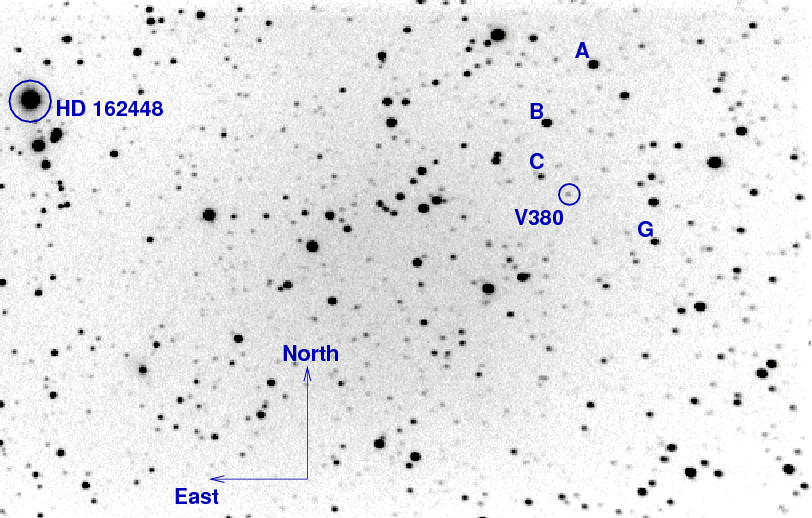
On the night of Aug 07/08, 2012, I observed the variable star V380 Ophiuchus in order to support upcoming HST observations of the star. Joe Patterson at Columbia University sent out a message to members of the Center for Backyard Astrophysics which stated in part
We're hoping to get an HST observation of V380 Oph, which has entered a low state, quite soon. To do that we have to monitor it visually with sufficient depth to get an idea of how bright it is. The fainter, the better... partly because it certifies that the white dwarf is dominating the light (the aim of the observation), and partly because a BRIGHT V380 Oph will fry the detectors (and therefore be forbidden by NASA).Snapshot magnitudes of V380 Oph are the main thing that's needed, rather than time series, which of course are our usual specialty. And - again unusual for us - "it's too faint for me" is not really an appropriate reaction here. Add frames, lengthen exposures, do whatever you need to measure the magnitude. It's likely to be around magnitude 18-19, maybe fainter.
The setup was:
Notes from the night
This was the first time I'd gone after a faint target since February, so there were a number of minor issues that I had to deal with. For example, the camera's dessicant was saturated with water, so I had to run the CCD above 0 degrees C to avoid forming ice crystals on the dewar window. I tried to rebalance the telescope, which involved moving the white finder telescope forward on its track; and THAT meant I had to re-align the white finder with the small finder and the main telescope, a task which took over an hour. The telescope is behaving somewhat differently than it did during my observations of SN 2011fe: when it is powered on, it doesn't present the same set of initialization options, and, after I've pointed manually to a bright star and synchronized the telescope, it can't move automatically to a nearby target. Fortunately, V380 Oph is not far from beta Oph, and I was able to starhop to the field.
This is a chart of the field of V380 Oph, based on a stack of eleven 30-second unfiltered images. The field of view is about 14 by 10 arcminutes.

The AAVSO provides magnitudes for a number of stars close to the variable star -- see their web site's Variable Star Plotter (VSP). I'll use the stars marked "A" and "G" above as my primary comparisons. According to the AAVSO,
Label V ------------------------ A 13.30 G 14.98 ------------------------
I took a series of 30-second unfiltered images. V380 Oph was _barely_ visible in each good image (after I had discarded the trailed ones), so I co-added eleven decent images using a median technique. As the chart above shows, V380 Oph is securely detected in this combined 330-second exposure.
The overall sensitivity of the unfiltered CCD, telescope, etc., is probably not too far from that of the V-band. I measured instrumental magnitudes for stars in the combined image using simple aperture photometry with a radius of 3 pixels = 5.6 arcseconds. The instrumental magnitudes for stars A and G differed from the V-band magnitudes provided by the AAVSO by 0.78 and 0.73 mag, respectively. Adopting an average offset of 0.75 mag, I compute a magnitude for V380 Oph of 17.4, with an uncertainty of perhaps +/- 0.4 magnitudes; the formal uncertainty due to counts in the image is about 0.1 mag, but the lack of a filter and lack of flatfielding increase the uncertainty significantly. Other observers reported similar values for the object on this night, so at least we're all consistent.
I sent a message to cba-data with the following report.
# Measurements of V380 Oph made at RIT Obs, Aug 8, 2012 UT, # in fair conditions, # by Michael Richmond, using 12-inch Meade LX200 and SBIG ST-8E CCD. # Exposures 10x30 seconds long, no filter. # Tabulated times are midexposure (FITS header time - half exp length) # and accurate only to +/- 1 second (??). # 'mag' is a differential magnitude based on ensemble photometry # using a circular aperture of radius 5.5 arcseconds. # which has been shifted to match AAVSO V-band magnitudes # for several nearby comparison stars. # # UT_day JD HJD mag Aug08.15000 2456147.650 2456147.653 17.4
Last modified 08/08/2012 by MWR.